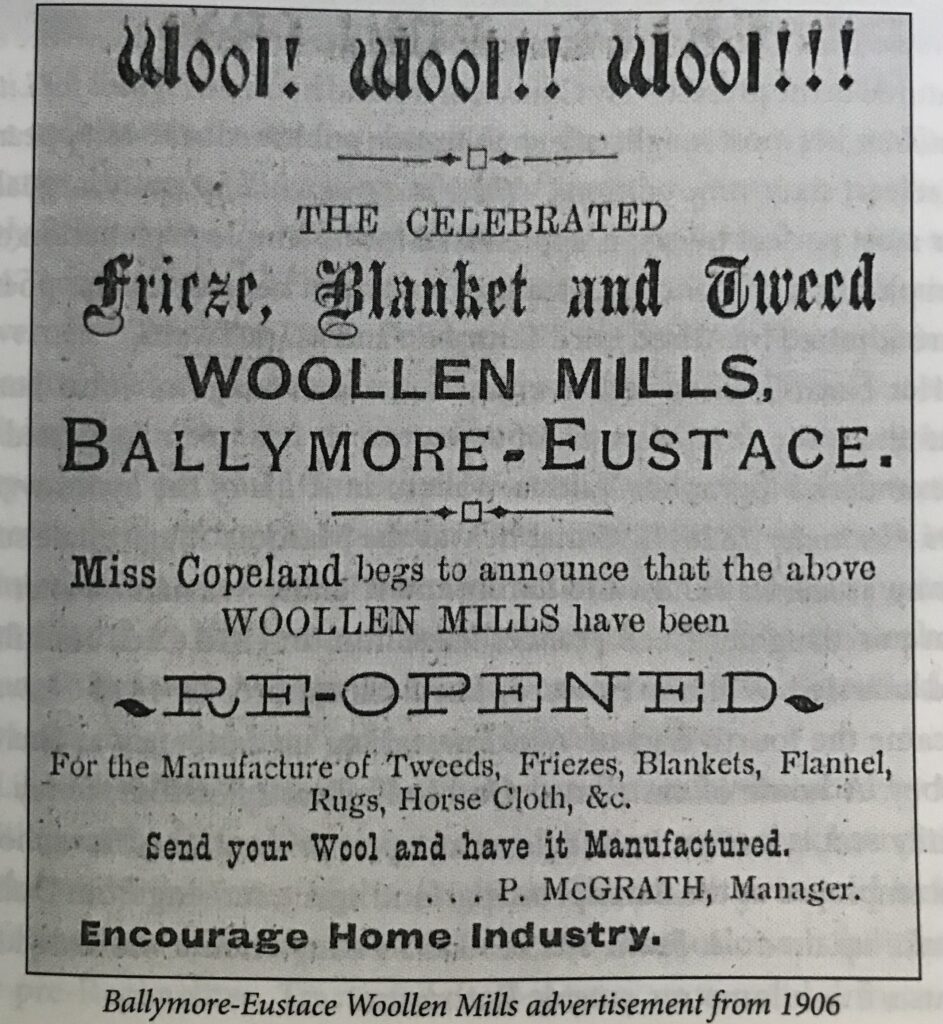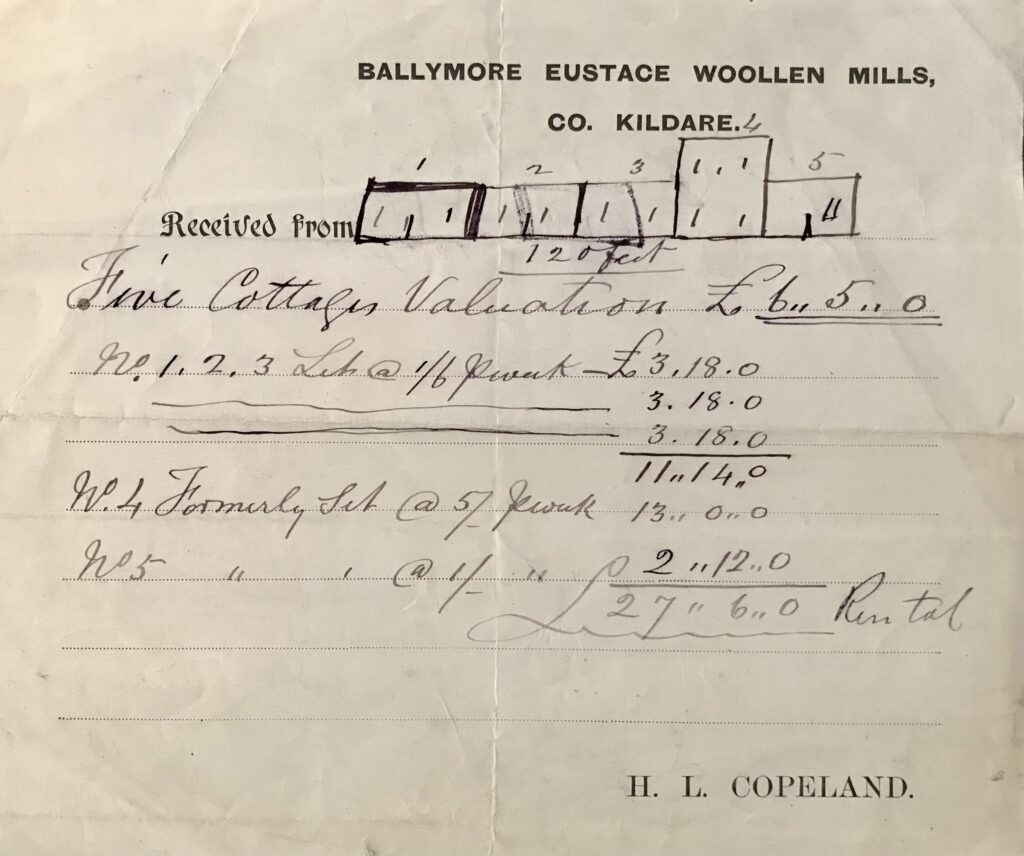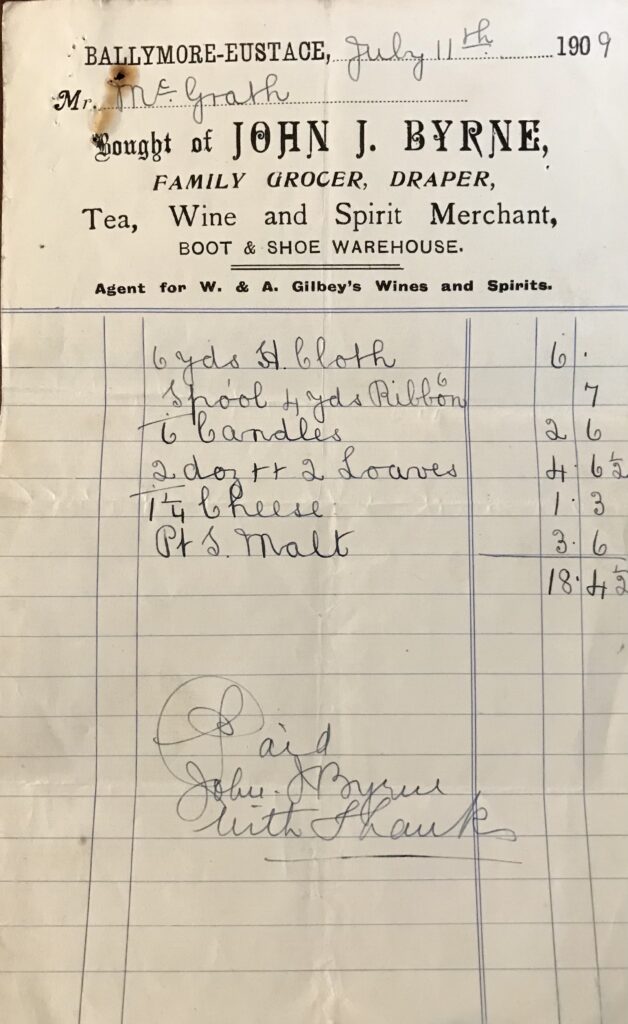The Last Copeland at Ballymore Eustace Woollen Mills.



The last Copeland, Mary Christina, died at the Mill House in July 1909. It was a sad ending for a family that had brought prosperity and employment to the town of Ballymore for more than a hundred years. For many of these years it had been a story of success. In famine times it kept people from starvation or a stretch in the dreaded workhouse in nearby Naas. Many of the workers were familiar with the hellhole as the factory supplied to it items such as blankets, serge, frieze and knitting worsted.
In the Census of 1901 we have, for premises number 25, the following names:
Henry L. Copeland-Owner-Catholic-Read & Write-56-Woollen Manufacturer-Not Married.
John A. Copeland-Brother-Catholic-Read & Write-65-Annuities-Not Married.
Mary C. Copeland-Sister-Catholic-Read & Write-67-Annuities-Not Married.
Catherine Copeland-Sister-Catholic-Read & Write-60-Annuities-Not Married.
Mary Cunningham-Servant-Catholic- Read & Write-45-Cook Domestic Servant-Not Married.
The 1901 Census was signed by Henry L. Copeland, Head of Family. It was enumerated by Constable Patrick C. Ryan.
Still on the premises we have a 1901 Census record for a house occupied by two ladies:
Sarah Burke-Head of Family-Roman Catholic-Read & Write-58-No Occupation, Living on Private Means-Not Married.
Bridget Hegarty-Boarder-Roman Catholic-Read & Write-30-Teacher of N.S.-Not Married.
Again: Signed by Sarah Burke, enumerated by Const. Patrick C. Ryan.
(According to C.J. Darby this cottage was beside Cnoc Avon, the Parochial House.)
Her brother Henry had died in the year 1903 and since then she, along with manager Patrick McGrath, and with the support of the factory solicitors, had been running affairs. She had not been very active in mill matters up to then and this was a great responsibility now thrust upon her at 69 years of age.
In his will her father John Copeland had left her an annuity of £45 per annum. The other sister and brother got something similar. John had acquired the Mill from Peter Drumgoole. Peter’s father Christopher Drumgoole, who got possession in 1803, built most of what we now have. The business was successful for several years. At one time, we are told, there were around 700 working there. Houses were provided for many of the workers.
What enticed a Dublin clothier like Drumgoole to invest so heavily at Ballymore? The reliable supply of free water power was an important factor. Wages would be somewhat lower and wool available near at hand. The Mill Race from the Liffey may well have been already in situ for the working of the Tuckmill and Cornmill from earlier times. If it was not then Drumgoole would surely have it built immediately he took over. A millwheel in the fast flowing Liffey could not be relied upon.
In the year 1854 Catherine Copeland and husband John Copeland had taken over the mills. Catherine was a step sister of Peter Drumgoole.
50 years later, however, the picture was a depressing one. To be in debt, not be able to repay it, and receiving threatening letters must be a harrowing experience indeed. Such is what Henry faced for some years previous to his death at the young age of 58.
Henry owed £250 to a Mr Fitzgerald at 6% interest per annum:
To Isabella Watters £600 at 6%:
To John Berkley (of Ballymore) £197 at 5%.
To Ulster Bank £168 at 7%.
To Thos Grace of Ballymore £25-14-5.
To Grace Bros. of Ballymore £39-10-7.
To Samuel Hemphill (Solicitor) £36-5-8.
To Rev.P. Kavanagh, Hollywood £32-1-11.
To Anthony Metcalfe (Auctioneer of Lemonstown) £15-6-6.
To Pronk Davis & Co. London £6-2-0.
To John Speares (Rathdrum) £9-12-0
There were several smaller debts.
Ms. Watters had written many letters to Mr Copeland concerning the debt and, more urgently, the interest on it. The annual interest would be £36. Many like her lived in genteel stringency on investments such as this one. In a letter at Christmas time 1900 she acknowledges £20 he has sent her but pleads for the remainder of the year’s interest as soon as possible. She ends offering him all the good wishes of the season.
Fitzgerald brought matters to a head and the company was put up for sale on the 6th of September 1904.
The following was for sale:
The Woollen Factory, Tuck Mill, Machinery, Gentlemanly Residence, with a strip of land adjoining at a rent of £19-10-0 per annum, stables and coach house.
Lands measuring 1rood-20 perches, Irish Plantation held for 999 years at 18/- per annum.
Lands measuring 2 roods-18 perches Irish Plantation for 99 years at £2-2-0 per annum
Lands called Bishopland measuring 22 acres 0 roods 6 perches statute at £18 per annum.
The lessors were the following:
Geoffrey Greene,
Thomas Driver,
Capt O’Connor Henchy and
Richard Wolfe.
An annuity of £45 per annum was payable to Miss Mary C. Copeland.
Not for sale was a small property in Crumlin, Co.Dublin or the 5 houses opposite the Factory but both had been offered as collateral in the mortgage to William Fitzgerald for the repayment of £250 in the year 1897.
No sale took place and with the backing of solicitor Hemphill and manager Patrick Mc Grath an effort would be made to revive the business. Soon after the Factory Auction failure Miss Copeland agreed to sell some of her house furniture. The auction took place in Ballymore and netted £189. Her more valuable books were sent by Tram to Dublin and sold for £53, making a total of £242, a sizeable sum. This money went to pay off many small debts and running expenses as follows starting in March 1905:
March28th: Patrick Mc Grath on account of wages………£20
April 4th : Dublin & Blessington Tram carriage of goods..…1/8
“ P. O’Toole carriage of goods to Tram……………..3/-
“ 22nd : James Mc Grath repairing furniture for auction…2/-
May 2nd: P. Mc Grath expenses to Dublin re water wheel…9/-
“ 5th: Brooks Thomas for timber…………………….£1-16-11
“ 6th: J. Mc Grath repairing water wheel………………….£1.
“ 8th: Leinster Leader 50 posters re opening of factory…6/4
“ 11th: Messrs Adams for report on furniture………£3-11-6.
“ 13th: J Smyth for 4 dozen bolts etc……………….……8/3.
J. McGrath : repairs to water wheel………………£1.
“ 15th: Capt. Henchy – 2 years rent……………………£4-4-0
George Wolfe – 2 years’ rent………..……..… £36
D. Donohoe for timber………………… ……….3/4
“ 16th: D. Dunne- Income Tax………………… …..£7-1-1
“ 18th : John Confrey -Poor Rate……………… …..£12-8-1
“ 20th : P. Mc Grath on account of wages………… …£20
J. Mc Grath : Repairs to water wheel…………….£1
“ 22nd: Brooks Thomas timber…………………… …….3/3
“ 24th Thomas Greene one year’s rent………… …£18-0-6
“ 25th D.& B. Tram carriage of goods………………….2/11
“ 27th James Mc Grath repairs to factory roof…………..£1
J. Tracy for lime…………………………………….1/6
E. Stephenson for nails……………………………2/4
“ 31st: A. Doran for nails…………………………… ……1/4
“ D. Donohoe for tar………………………………..2/6
June 2nd : James Smyth for bolts…………………………….3/2
“ 3rd : James Mc Grath 5 days wages…………………..16/8
E. Stephenson for Brush……………………………1/-
“ 10th James Mc Grath for 6 days wages………………..£1
D & B Tram carriage of wheel segments…… …3/2
D. Donohoe for tar………………..……………… 2/6
“ 12th : P.O’Toole wheel from tram to factory……………2/-
“ 17th : James Mc Grath 6 days wages… ……………£1
“ 19th P. O’Toole…………………………… ………….1/-
“ 22nd P. Mc Grath expenses Dublin re wheel………. 4/6
“ E. Stephenson for nails…………… …….….1/11
“ 24th : James Mc Grath 5 days wages………….……16/8
“ 28th : Brooks Thomas for oil…………………………..16/3
Elvery & Co. for machine belt……………………4/6
D & B Tram carriage of oil………………………..0/9
July 1st : James Mc Grath 5 days wages……………… .. …16/8
“ 5th Blessington Tram carriage of wheel……………….…1/10
“ 8th : James Mc Grath 6 days wages………………….…….£1
15th : Do. ………………………..£1
“ 17th M. J. O’Connor Income Tax…….…………………£2-8-6
Greenmount Oil Co…………………………………£1-5-0
J. Sharkey for casting segments of wheel….. . £5-8-0
“ 26th: P. Connor 4 keys………………………………………6/0
E. Stephenson for Brush………………………………1/0
A. Doran for shovel……………………………………..0/8
“ 31st : P.O’Toole for coal…………………………………£1-1-0
Aug. 8th : E. Stephenson for nails……………… ……..………1/6
“ 12th : Printing Circulars……………………………….…….3/6
“ 14th : A. Doran for Rope………………-……………….….0/6:
“ 16th : J. Confrey for Poor Rates………………………..£4-1-1
“ 26th : J. Mc Grath : Wages……………………………….18/-
Cathcart & Hemphill Sols. For refund of 2½ years’ rent of factory to March 1905……..……… ….…..……..£44-16-0
Patrick Mc Grath Advance of wages………………£5
Patrick Driver for 4 years’ rent……… ………£3-8-2
Patrick Mc Grath on account of wages…………£10
We can see from these payments that a great effort was made by Miss Copeland to come to terms with the many debts. It cannot have been easy for her to sell the quality family furniture and valuable books. Indications are that the Drumgoole and Copeland families had lived well as evidenced by their substantial residence, pleasure grounds and furniture. Later a very large selection of books, pictures and less valuable furniture was sold.
We can see from some lots of these that the family took the practice of their religion seriously. For instance: Lots 19, 20 and 21 were 3 Prie dieux (used for kneeling on when at prayer), Lot 23 was an Altar, Lot 69 was Old Catholic Directories and Lot 74 Lives of Irish Saints. Mary Christina and her brother were said to be charitable.
In the 19th Century many Catholic families were engaging in trade and manufacture and with considerable success. They were often great supporters of the Catholic Church. We see this in the donations they made to the building of impressive churches throughout the country. The Drumgooles and later the Copelands may well have fitted into this category. They were never quite accepted by the gentry, of course, as they were merely ‘in trade’.
Records show that some progress was made by Miss Copeland and Patrick McGrath to get the Mill back to a healthy financial state. There was some income for the renting of the 5 houses across from the gate and the 2 houses on site. For instance we have the amount received in rents from April 1906 to April 1907 as follows:
Thomas Kerry…………….£4-0-0
Elizabeth Keogh………….£5-11-0
Mrs Anne Devoy………….£3-19-6
Mrs Homan………………..£10-8-0
Mrs McDonald…………….£2-13-0
Henry Price…………………£1-3-6
James Kelly……………………6-6,
Making a total of …………..£28-1-6.
There were expenses in connection with this income. Patrick McGrath received commission of 5% for collection of rents. In the year 1909 privies were provided to the houses by Patrick Byrne of Swordlestown for a sum of £20-0-0. Unexpected problems could arise with letting. For instance, in the year 1909 Patrick McGrath got notice from a tenant who claimed that he had moved into his house about 30 years previously as caretaker at 1 penny per week to be paid by Mr. Copeland. This money had never been paid to him. He intended holding the house until the money was paid. No record of this agreement was found. (The cottages were eventually sold to Mrs Purcell in the year 1916.)
There was also an income for letting the land behind the mill, circa 25 acres, for grazing or hay making. For instance in 1906 John Walsh paid £16-17-6 for the grazing of 15 acres. Or in the year 1907 we see that ‘meadow on foot’ brought in a total of £17-12-6. Anthony Metcalf J.P. of Lemonstown looked after the letting. P. Dunne of Broadleas charged a Survey Fee of 8/0.
In 1908 Mr Gregory Doyle paid £21 for the grazing of 14 acres
The fields had their own names:
1. Slang (an old Scottish word for a strip of land along water)
2. Duke of York Park,
3. Tenter Field,
4. Barn Field,
5. High Field,
6.Swimming Field.
But the financial position continued to be problematic.
A profit and Loss account for the years 1907 to 1915 shows this:
Goods sold 1907 £159 incurring a loss of £15.
“ 1908 £315 “ £114
“ 1909 £287 “ £108
“ 1910 £334 “ £70
“ 1911 PROFIT of £90
“ 1915 £337 loss of £76
There had been a brief revival in the year 1911.
Miss Copeland’s funeral was a humble affair, in keeping I suppose with her impoverished position. She had relied for personal expenses on the £45 annuity left her by her father. It was difficult enough to scrape together this sum of money each year in such straightened circumstances. Found in her room after her death was a paltry £2-15-0. Total funeral expenses came to £8-2-9. The factory solicitor, Mr. Hemphill came up with £6 to tide things over.
But the Phoenix is rising from the ashes, and the new forward-looking proprietors are taking a leaf from the copybook of that mystical bird. The buildings, and they are ample, will be used for the bonding of Whiskey ‘the water of life.’ I can visualise the ads on the far side of the Atlantic.
“Ballymore Whiskey”- matured on the banks of the River Liffey, James Joyce’s own Anna Livia. With maybe the Falls at Poulaphouca thrown in. Let’s raise a glass of “Ballymore” to the Copelands and the Drumgooles who came before them.
Slainte maith !
Any comments or questions would be welcome: To contact Jim Corley please click here